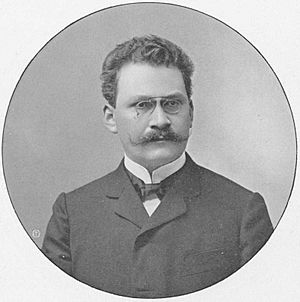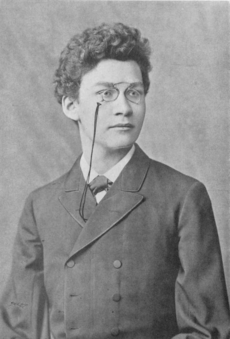Hermann Minkowski facts for kids
Quick facts for kids
Hermann Minkowski
|
|
|---|---|
 |
|
| Born | 22 June 1864 |
| Died | 12 January 1909 (aged 44) |
| Citizenship | Russian Empire or Germany |
| Alma mater | Albertina University of Königsberg |
| Known for |
|
| Spouse(s) | Auguste Adler |
| Children | 2 |
| Scientific career | |
| Fields | Mathematics, physics, philosophy |
| Institutions | University of Göttingen and ETH Zurich |
| Doctoral advisor | Ferdinand von Lindemann |
| Doctoral students | Constantin Carathéodory Louis Kollros Dénes Kőnig |
| Signature | |
Hermann Minkowski (22 June 1864 – 12 January 1909) was a German mathematician and professor. He taught at the University of Königsberg, Zürich, and Göttingen. He developed the "geometry of numbers". This method uses geometrical ideas to solve problems in number theory, mathematical physics, and theory of relativity.
Minkowski is best known for his important work on space and time. He described them as a four-dimensional space. This is now called "Minkowski spacetime". His ideas helped people understand Albert Einstein's special theory of relativity (1905) better.
Contents
About Hermann Minkowski's Life
Hermann Minkowski was born in Aleksotas, a town in what was then the Kingdom of Poland. This area was part of the Russian Empire in 1864. His parents, Lewin Boruch Minkowski and Rachel Taubmann, were of Jewish descent. His father was a merchant. Hermann also had an older brother named Oskar Minkowski, who became a famous medical researcher.
In 1872, his family moved to Königsberg. They moved to escape persecution (unfair treatment) against Jewish people in the Russian Empire. In Königsberg, his father worked in rag export and later made mechanical clockwork toys.
Minkowski studied in Königsberg. He later taught in Bonn (1887–1894), Königsberg (1894–1896), and Zurich (1896–1902). From 1902 until his death, he taught in Göttingen. He married Auguste Adler in 1897. They had two daughters. His son-in-law was the electrical engineer Reinhold Rudenberg.
Minkowski died suddenly on January 12, 1909, in Göttingen. He had appendicitis. David Hilbert, a close friend and fellow mathematician, wrote a touching tribute to him. Hilbert said that Minkowski was his "best, most dependable friend." He also said their shared love for science brought them together.
An asteroid in space, 12493 Minkowski, is named after him.
Hermann Minkowski's Education and Career

Minkowski studied at the Albertina University of Königsberg in East Prussia. He earned his doctorate degree there in 1885. His advisor was Ferdinand von Lindemann.
In 1883, while still a student, he won a big award. He received the Mathematics Prize from the French Academy of Sciences. He won it for his work on the theory of quadratic forms. A quadratic form is a special type of mathematical expression. He was only 18 years old, which was very unusual for such a prestigious award. He shared the prize with a famous English mathematician, Henry John Stephen Smith.
Minkowski became friends with another well-known mathematician, David Hilbert, during his university days. His brother, Oskar Minkowski, was also famous as a doctor and researcher.
Minkowski taught at several universities. These included Bonn, Königsberg, Zürich, and Göttingen. At the Eidgenössische Polytechnikum (now ETH Zurich), he was one of Albert Einstein's teachers.
Minkowski studied the math of quadratic forms. This led him to think about geometric shapes in spaces with many dimensions. In 1896, he introduced his "geometry of numbers." This was a new way to solve problems in number theory using geometric ideas.
In 1902, he joined the Mathematics Department at Göttingen. There, he worked closely with David Hilbert, whom he had met in Königsberg. Constantin Carathéodory was one of his students at Göttingen.
Minkowski's Work on Relativity
By 1908, Minkowski understood something very important about special relativity. This theory was introduced by his former student Albert Einstein in 1905. Minkowski realized that special relativity could be best understood in a four-dimensional space.
This special space is now called "Minkowski spacetime". In this space, time and space are not separate things. Instead, they are mixed together into a single space–time. This idea helped to show how the Lorentz geometry of special relativity works. It made the theory much clearer to understand.
The mathematical ideas behind Minkowski space were already known in the 1800s. They were part of the hyperboloid model of hyperbolic space. This model showed how movements in hyperbolic space relate to Lorentz transformations.
See also
 In Spanish: Hermann Minkowski para niños
In Spanish: Hermann Minkowski para niños
- List of things named after Hermann Minkowski
- Abraham–Minkowski controversy
- Brunn–Minkowski theorem
- Hasse–Minkowski theorem
- Hermite–Minkowski theorem
- Minkowski addition
- Minkowski (crater)
- Minkowski distance
- Minkowski functional
- Minkowski inequality
- Minkowski model
- Minkowski plane
- Minkowski problem
- Minkowski problem for polytopes
- Minkowski's second theorem
- Minkowski space
- Minkowski's bound
- Minkowski's theorem in geometry of numbers
- Minkowski–Hlawka theorem
- Minkowski–Steiner formula
- Smith–Minkowski–Siegel mass formula
- Proper time
- Separating axis theorem
- Taxicab geometry
- World line

